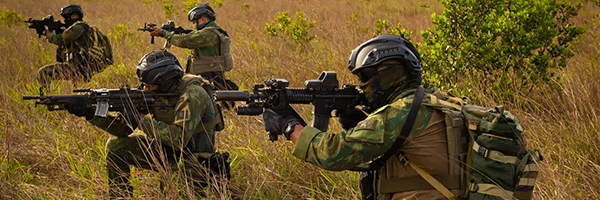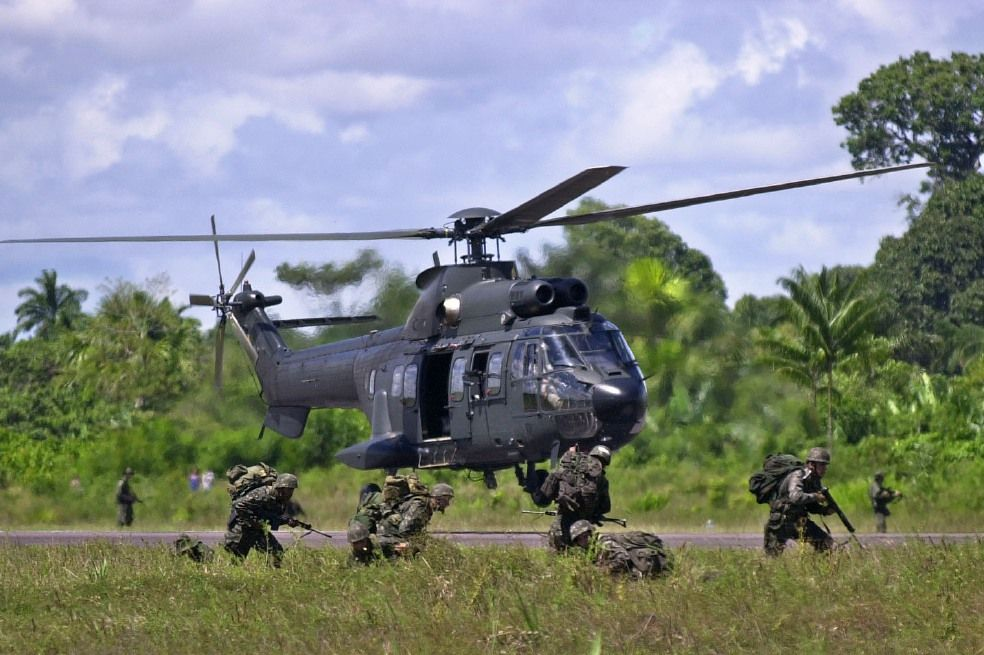Growing US Military Presence in Brazil
 Raphael Machado, Orinoco Tribune, December 4, 2023 —
Raphael Machado, Orinoco Tribune, December 4, 2023 —
The CORE23 military exercise, which lasted 10 days in the jungle of Amapá, in northern Brazil, and in which 1,500 Brazilian and US military personnel participated, came to an end this week.
CORE23 (Combined Operation and Rotation Exercise), which is part of an agreement authorizing constant annual US exercises in Brazil until 2028, is officially aimed at sharing experiences, techniques, and tactics to improve interoperability between our [Brazil’s] military and those of the US in the Brazilian jungle.
The agreement in question, which deals with military cooperation between Brazil and the United States, was signed in 2010 during the second Lula administration and enacted in 2015 during the second Dilma Rousseff administration, resulting in Decree No. 8,609/2015.
In August of that year, members of the US Marines participated in Exercise Formosa, near Brasilia (in the midwest region, near the Cerrado, the geopolitical heart of South America). In this exercise, the US Marines learned the tactics of our Marines, and even received cognitive courses with the stated objective of reinforcing the integration of these forces to face “common security challenges.”
In July, the Brazilian Navy participated in UNITAS 2023, a naval exercise organized by SOUTHCOM which, this year, took place in Colombia (and last year in Brazil). The stated objective was to enable the US to operate as part of a larger maritime force to control the sea and deny it to potential enemies.
The Americans were also here in September 2022, in Parana, southern Brazil, at the headquarters of the 15th Mechanized Infantry Brigade to conduct joint strategy exercises for military engagement in a “hypothetical” Latin American country experiencing a “humanitarian crisis.”
Between August and September 2022, for its part, the US Air Force participated in EXCON Tápio, in Mato Grosso do Sul (a sensitive region for Brazilian agriculture), with the objective of “doctrinal development of joint tactics,” with a view to contributing to “world order and peace.”
In the middle of the year, in addition to the aforementioned UNITAS 2022, held in Brazil, Brazil send soldiers to be indoctrinated in the United States as part of CORE22.
I believe it is unnecessary to continue listing exercises, year by year, to demonstrate a growing trend towards greater integration between the Brazilian and American Armed Forces as well as a greater influence of the United States in the training of Brazilian military personnel—not to mention something equally important: the accumulation of experience and knowledge by the Americans about our geography, our biomes, our reliefs, as well as their strategic and tactical importance in “possible” and “hypothetical” operations taking place in our territory.
In addition to these exercises, we should not forget the “diplomatic” visits of US military authorities, in particular, Laura Richardson, SOUTHCOM Commander, since 2021. She was in Brazil in November 2021, where she visited the Minister of Defense, the Chairman of the Joint Chiefs of Staff, as well as the heads of each of the branches of the Brazilian Armed Forces in addition to visiting the Amazon Military Command, the Army Jungle Warfare School, and other facilities. During these visits, she emphasized the desire for greater military integration between Brazil and the United States as well as the strategic role of joint action between the two countries in the South Atlantic.
She returned in May 2023, when she met again with the Joint Chiefs of Staff in addition to the Armed Forces Chiefs of Arms, the headquarters of the Aerospace Operations Command, and the headquarters of the Army Cyber Defense Command, again reiterating themes such as military integration and coordination to eliminate regional threats.
We will not mention Laura Richardson’s numerous statements about Brazil. They range from stating that the natural resources of the Brazilian Amazon are of strategic interest to the United States to claiming that Russia, China, and Iran have “malign intentions” in Latin America (days before the US State Department published a report accusing me of being an “agent” in the service of Russia and of running an organization that is a front for Russian intelligence).
It seems beyond doubt, therefore, that militarily, the United States has been projecting itself towards South America and that Brazil has been, to a certain extent, its collaborator in this. It is not for us to comment here on rapprochement and collaboration in other fields.
What remains, however, is to understand the geopolitical logic of this phenomenon.
Brazil’s participation in World War II in the Italian Theater led to a high degree of integration between the Brazilian and American Armed Forces. This rapprochement took place in all areas, but the most important was the psychological one.
Since then, the Brazilian Armed Forces have positioned themselves in the Atlanticist camp, seeing Brazil as part of Western civilization and perceiving liberal democracy on the US model as the ideal form of government. To obtain an idea of the impact, the same year that the Brazilian military returned from Italy after the end of the war, in 1945, they overthrew Getúlio Vargas, a nationalist dictator who had tried to lead Brazil down a sovereigntist path and who, later, together with Argentina’s Perón, planned continental integration.
Needless to say, 1945 led directly to the US military coup, carried out under the blessing of the United States and with some collaboration from the US Embassy.
But lest it be said that the Brazilian Armed Forces are irredeemable, it is curious that it was precisely during the military period, specifically under the dictator Ernesto Geisel, that Brazil condemned Zionism as racism and began to support the Palestinian cause; that Brazil recognized the People’s Republic of China and initiated diplomatic and commercial relations with the CPC; that Brazil recognized and supported the Angolan revolution of socialist inspiration; that Brazil created most of its state enterprises in the 20th century; that Brazil began to collaborate with Saddam Hussein’s Iraq in the nuclear field, etc.
Demonstrating the contradictory and dialectical character of history, just as the United States brought the military to power to overthrow a government that followed a non-aligned and developmentalist geopolitical path, they overthrew the same military because they had initiated a non-aligned and developmentalist path.
This contradictory character of the Brazilian military remains. There is an Atlanticist spirit that permeates all areas of the Brazilian Armed Forces, especially in the General Staff, but there is still a more sovereigntist and multipolar tendency within the Armed Forces, especially in the intellectual centers of the Armed Forces and in certain middle layers of the officer corps.
Now, returning to the main question, what is the geopolitical significance of this intensified US military presence in synergy with the Brazilian military?
It is important to repeat a “theme” we have touched on before: the United States feels that its positions in Eastern Europe, the Middle East, Africa, and Asia are threatened. In this sense, while the United States is bent on waging wars of attrition around the world to weaken the major non-aligned powers, the unipolar hegemon is approaching our America.

The objective is to secure our region as a megacontinental space in which its supremacy will be undisputed, burying our multipolar pretensions and transforming the Americas as a whole into an “island” in the classic geopolitical sense of the term, that is, into a thalassocratic platform from which to harass a potentially liberated or liberating Euro-Afro-Asian world.
To this end, the United States faces a series of obstacles in our continent. The most important immediate obstacle is Venezuela, clearly counter-hegemonic, bent on building important geopolitical bridges with Russia, China and Iran, and now focused on beginning to resolve the problem of the Guyanas.
The main immediate obstacle, in turn, is Brazil, due to the fundamental geopolitical potential of the country in question, involving its size, demographics, water and energy resources, agricultural capacity, and, of course, the Amazon and its usefulness in the biomedical and pharmaceutical fields. It should also be noted that the Amazon River, whose mouth flows into northern Brazil, is an extremely navigable river that makes it possible to reach, through its tributaries, the interior of Bolivia, that is, that area which, together with part of Central-West Brazil, northern Paraguay and northern Argentina, has been considered by Ibero-American geopoliticians as the “Heartland of South America.”
Hence the importance of trying to instrumentalize Brazil against Venezuela, a task that does not seem to be completely finished even with the transition from an openly anti-Venezuelan right-wing government to a left-wing government that theoretically would be more sympathetic to Venezuela.
It is not known, however, to what extent the Brazilian government is fully aware of these geopolitical trends and intentions. Most likely, as can be deduced from other geopolitical positions of the Brazilian government, Brazil is simply unprepared for this “era of tensions” brought about by the multipolar transition.
It should be noted that Brazil has insisted on “free elections” in Venezuela, serving as a mouthpiece and objectively at the request of the United States, as a “conciliatory” and “soft path” (after the failed coup attempts and the color revolution), but still inserted in the Atlanticist–globalist logic.
In conclusion, it is not possible to separate the intensification of joint US–Brazilian military exercises in the Amazonian territory with a project to pressure and encircle Venezuela, to prevent it from achieving its geopolitical objectives, and perhaps even to undertake regime change against Caracas.
Naturally, this military presence also constitutes a “bayonet” directed against the host country itself, as it serves to train the US military for possible military operations aimed at securing areas of interest to the United States in case of possible future political upheavals.
